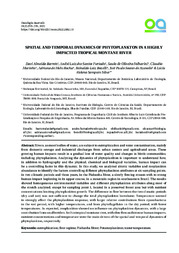Spatial and temporal dynamics of phytoplankton in a highly impacted tropical Montane River.
Spatial and temporal dynamics of phytoplankton in a highly impacted tropical Montane River.
Author(s): BARRETO, D. A.; FURTADO, A. L. dos S.; FOLHARINI, S. DE O.; MARINHO, C.; ROCHA, A. DE M.; BOZELLI, R. L.; AZEVEDO, J. P. S. DE; SILVA, L. H. S.
Summary: Rivers, as most bodies of water, are subject to eutrophication and water contamination, mainly from domestic sewage and industrial discharges from urban centers and agricultural areas. These growing human impacts result in a gradual loss of water quality and changes in biotic communities, including phytoplankton. Analyzing the dynamics of phytoplankton is important to understand how, in addition to hydrography and the physical, chemical and biological variables, human impact can be a controlling factor in this dynamic. In this study, we analyzed abiotic variables and zooplankton abundance to identify the factors controlling different phytoplankton attributes at six sampling points, in two climatic periods and three years, in the Piabanha River, a slowly flowing stream with to strong human impact beginning in its upper course, in a mountain region in southeastern Brazil. The results showed homogeneous environmental variables and different phytoplankton attributes along most of the stretch analyzed, except for sampling point 1, located in a preserved forest area but with nutrient concentrations limiting phytoplankton growth. The difference in flow between the two climatic periods (dry and wet) was not sufficient to change the total phytoplankton biovolume. Temperature seemed to strongly affect the phytoplankton response, with larger relative contributions from cyanobacteria in the wet period, with higher temperatures, and from phytoflagellates in the dry period, with lower temperatures. As expected, zooplankton showed no influence on phytoplankton dynamics, with a large contribution from small rotifers. In this tropical montane river, with slow flow and intense human impacts, nutrient concentrations and temperature were the main drivers of the spatial and temporal dynamics of phytoplankton, respectively.
Publication year: 2022
Types of publication: Journal article
Unit: Embrapa Territorial
Keywords: Eutrophication, Flow regime, Piabanha River, Potamoplankton, Water temperature
Observation
Some of Embrapa's publications are published as ePub files. To read them, use or download one of the following free software options to your computer or mobile device. Android: Google Play Books; IOS: iBooks; Windows and Linux: Calibre.
Access other publications
Access the Agricultural Research Database (BDPA) to consult Embrapa's full library collection and records.
Visit Embrapa Bookstore to purchase books and other publications sold by Embrapa.

